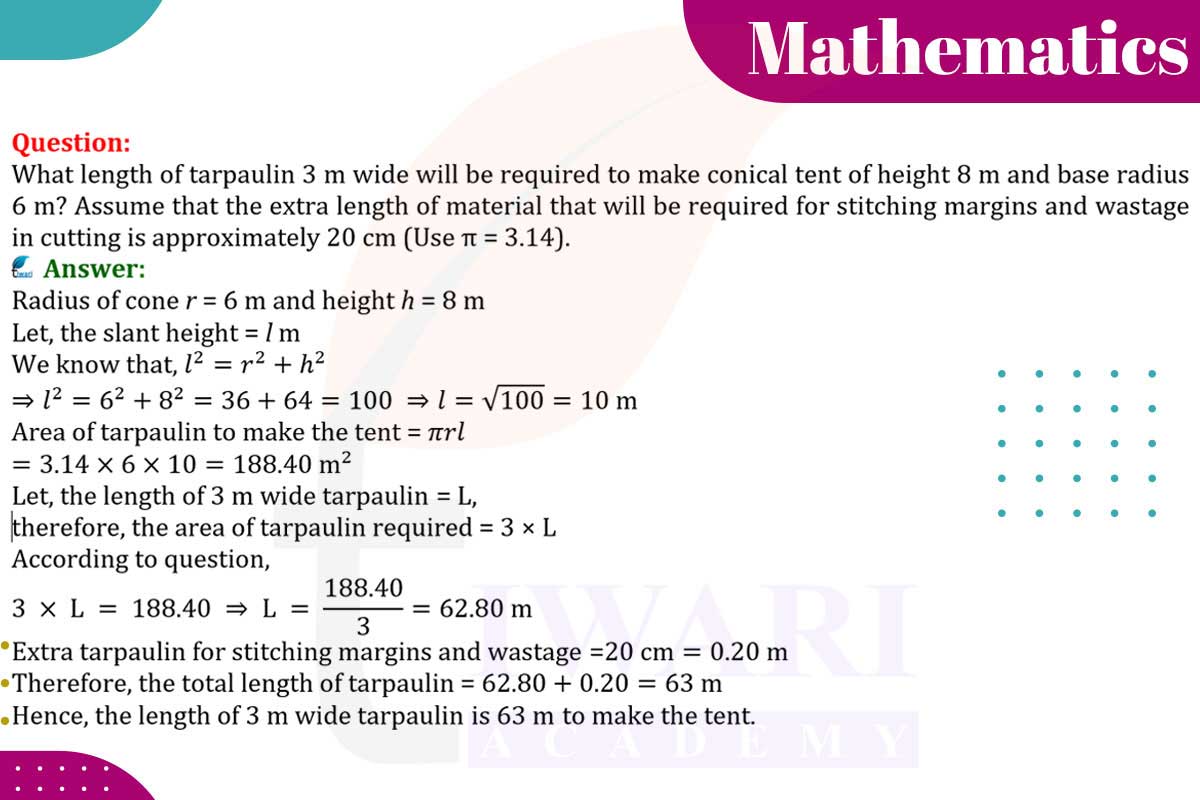To make a conical tent of height 8 m and base radius 6 m, first calculate the slant height using Pythagoras’ theorem: l = √[8² + 6²] = √[64 + 36] = √[100] = 10 m. The curved surface area is 3.14 × 6 × 10 = 188.4 m². For a 3 m wide tarpaulin, the length needed is 188.4/3 ≈ 62.8 m. Adding 20 cm for margins, the total length required is approximately 63 m.

Let’s discuss in detail
Introduction to Tent Construction
Constructing a conical tent requires a thorough understanding of geometry and material estimation. In this scenario, we are tasked with determining the length of tarpaulin needed to create a conical tent with specific dimensions. The tent’s height is 8 meters, and the radius of its base is 6 meters. Additionally, we must account for extra material for stitching margins and wastage, which is a common consideration in practical applications.
Calculating the Slant Height
The first step in our calculation is to determine the slant height of the tent. The slant height is the distance from the top of the tent (vertex) to the edge of the base, measured along the surface of the tent. This can be calculated using Pythagoras’ theorem, which states that in a right-angled triangle, the square of the hypotenuse (slant height) is equal to the sum of the squares of the other two sides (height and radius).
Applying Pythagoras’ Theorem
For our conical tent, the height (h) is 8 meters, and the radius (r) is 6 meters. Using Pythagoras’ theorem, the slant height (l) is calculated as l = √[h² + r²]. Substituting the given values, we find l = √[8² + 6²] = √[64 + 36] = √[100] = 10 meters.
Determining the Curved Surface Area
The next step is to calculate the curved surface area of the tent, which is essential for determining the amount of tarpaulin required. The curved surface area of a cone is given by the formula πrl. With a radius of 6 meters and a slant height of 10 meters, the curved surface area is 3.14 × 6 × 10 = 188.4 square meters.
Calculating the Required Tarpaulin Length
Given that the tarpaulin is 3 meters wide, the length of tarpaulin needed can be calculated by dividing the total curved surface area by the width of the tarpaulin. Therefore, the length required is 188.4/3 ≈ 62.8 meters. However, we must also consider additional material for stitching margins and wastage.
Final Calculation and Practical Considerations
Taking into account an extra 20 cm for margins and wastage, the total length of tarpaulin required is approximately 63 meters. This calculation is crucial for efficient use of materials and cost estimation in the construction of the tent. It demonstrates the practical application of geometric principles in real-world scenarios, emphasizing the importance of accuracy in measurements and allowances for additional material in manufacturing processes.
Discuss this question in detail or visit to Class 9 Maths Chapter 11 for all questions.
Questions of 9th Maths Exercise 11.1 in Detail

